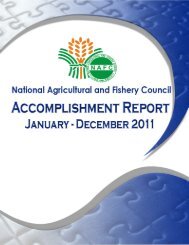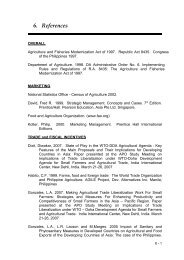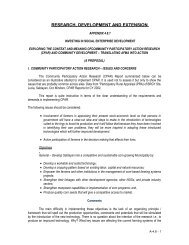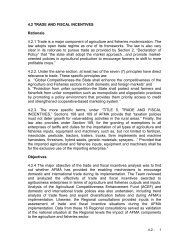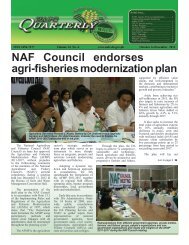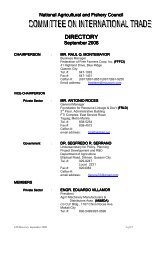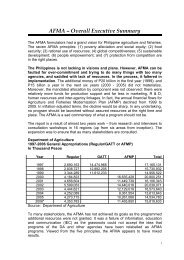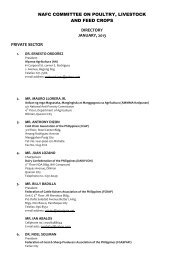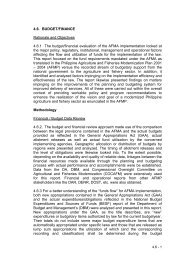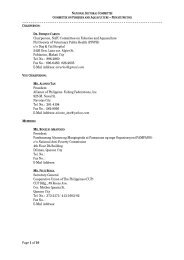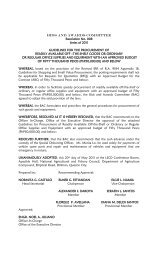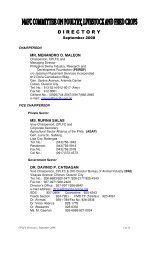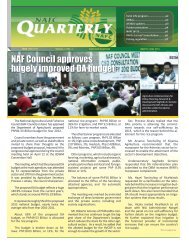5. Key Commodity Performance - National Agricultural and Fishery ...
5. Key Commodity Performance - National Agricultural and Fishery ...
5. Key Commodity Performance - National Agricultural and Fishery ...
Create successful ePaper yourself
Turn your PDF publications into a flip-book with our unique Google optimized e-Paper software.
strong technical competence on processing technologies. However, postharvest<br />
facilities are lacking during the main season. Processors complain of high cost of<br />
mechanical drying. Facilities available for them are either outmoded or poorly<br />
managed. There are also inadequate processing facilities in the rural areas. The<br />
dem<strong>and</strong> for the postharvest facilities enhances the research <strong>and</strong> acquisition of<br />
the government <strong>and</strong> private sector of the modern postproduction technologies.<br />
These technologies increase the capacity of the postproduction manufacturing<br />
industry <strong>and</strong> after-sale services. The investment for processing technologies is<br />
needed because there is an increasing dem<strong>and</strong> for rice-based food products.<br />
<strong>5.</strong>1.24 One of the problems of the agricultural sector is the instability of supply of<br />
the commodity such as rice in a given time of the year. Thus, a facility like<br />
storage is needed to make rice available at any time. The rice sector is gifted<br />
with the availability of warehouse spaces. However, storage facilities are either<br />
not in good condition or located at displaced areas. Farmers should consider<br />
storage because of the seasonality in supply. Prices are high when the<br />
commodity is not in season. The industry should take into consideration the<br />
declining public investments in storage facilities.<br />
<strong>5.</strong>1.25 Established marketing channels characterize the marketing subsystem of<br />
the rice sector. However, presence of the numerous market intermediaries<br />
makes marketing <strong>and</strong> distribution perform inefficiently. There is an increase in the<br />
marketing costs as another middleman joins the system. High transport costs<br />
also add to the price paid by the consumers. Also, inadequate infrastructure<br />
increases the cost of the middleman. Although the marketing subsystem is<br />
confronted by quite a number of inefficiencies, there are still markets not totally<br />
exploited. Rice sector has a continually growing huge consumer base because it<br />
is the staple food for the Filipino. Dem<strong>and</strong> for rice will increase as population<br />
increases. The threats to marketing <strong>and</strong> distribution subsystem include the<br />
budgetary constraints of NFA limiting procurement to less than 10% of total<br />
marketed paddy, entry of cheaper imports <strong>and</strong> rice smuggling.<br />
<strong>5.</strong>1.26 The institution subsystem shows the rice sector having strong linkages<br />
<strong>and</strong> partnership with institutions focusing on rice researches such as PhilRice<br />
<strong>and</strong> Rice R&D Network, IRRI, UPLB, SCUs, NFA, <strong>and</strong> other private companies.<br />
These institutions extend consultations <strong>and</strong> services to the rice sector with the<br />
aim of increasing the yield per hectare <strong>and</strong> the income received by the farmers.<br />
However, the institution subsystem performs poorly in terms of governance. Rice<br />
programs are put off because of frequent turnover of DA leadership. There is<br />
also ineffective implementation of the national rice programs. Access of the rice<br />
sector to international donor agencies like the FAO <strong>and</strong> USAID make it possible<br />
for the government to continue research <strong>and</strong> development. An expansion of the<br />
market for the rice sector is also possible because of the country’s membership<br />
to international trade associations such as AFTA <strong>and</strong> WTO. Coordination among<br />
the national <strong>and</strong> local governments is imperative in the implementation of rice<br />
programs.<br />
5- 8



